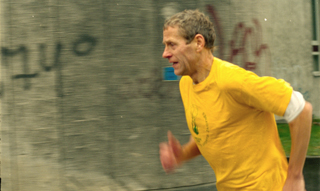Lost in the Mist

There are hardly a few still, static shots in the new film by Audrius Stonys, Ūkų ūkai (Mist of Mists). Everybody moves, walks, runs here. Some do because this is the profession they have chosen voluntarily (a marathon runner, a ballerina); others, because an off-screen voice tells them to move, to feel their body and be in harmony with nature in the manner of autogenic training (but this is also a voluntary choice). The evening coming or a clock being wound up, shown several times, confirms the same: time flows, runs. Some accept this quietly, and the off-screen instructions about harmony and peaceful thoughts are not necessary to an old lady: she knows this without any additional artificial means. Others try to achieve this, but, it seems, most of them do not need that off-screen influence either: they try to save themselves in their own ways and accept that as their norm. The voice was added during the editing process because it does not sound in people’s rooms, headphones, and environment. Movement, running in the first shots by camera obscura from which cinematography started, is born here particularly unnaturally and denies the essence of pure documentary. The directed, ‘staged,’ documentary has been legitimised as ‘poetic’ in long ago; but it already makes another step towards the rational side here.
Ūkų ūkai: such a title seemed to be possible only in the time of that other, ‘poetic,’ documentary. Today we understand that Stonys will either mock at it or the title will mean something else. And since there is hardly any mist in the film, only a couple of shots (The Christmas Sky above
Yet even with this approach, the director does not mock at that ‘healthy’ craze, however artificial it was, however artificially that voice was added to the image. The director records or, more precisely, asks whether it is right to save oneself from the Faust syndrome in this manner: to stay in the wonderful moment, which, for many, is wonderful only when they are healthy. It would seem that Stonys, who has filmed so many elderly people and their peaceful navigation to their harbours, has only now started to think about the real state of the old age: the inability to do what it was so easy to do before. He has discovered that the old age is not so much a spiritual or philosophical category as an absolutely physical state. The film Ūkų ūkai sometimes claims that it really is “the bodies of bodies”: this is a signal from the unhealthy society that propagates a healthy life-style and a young beautiful body, which also crosses out those who cannot walk so fast. And the physical weight of the shot is perceived here very strongly.
Another thing is that Stonys who, in his shots, had masked himself with the same mists or their misty sequences so often before, now tells us that he thinks through his clearly and beautifully, brightly, filmed shots in philosophical and literary oppositions and not only now, but almost always. Here he opposes a static shot (a lying or waiting body) to a moving one (running and active); a still state to those who practice laughter therapy. Natural to the artificial. However, this looks like writing a dictionary of synonyms, because one shot does no longer follow from the previous one; it is generated not by the cinematic or visual matter, but simply by another reflection on the concept ‘to move,’ and sometimes even illogical: movement in a prison courtyard, exercise in a room are rather aspects of saving oneself, but not of a task purposefully imposed. Stonys succumbs to the temptation to show a running man in a long and almost single shot because he knows very well that this magnetises the viewer (do you remember Bad Blood by Leos Carax? And the drivers in a tunnel staring through the window for several minutes in Almost America?) In another shot, a dog will run; in the third one, a new day will follow the previous one, and a woman in her room will walk in a circle, clockwise and anticlockwise. But whenever we hear the voice or intensive music, Stonys asks again: which is the more correct way to age? As if this was an ethical problem.
“Understand your feelings,” the voice says. This is what the director does: he tries to understand them, but the answer is not clear because Stonys himself gets lost in the mist and forgets that he has asked something. But what is it then? Just an anthem to movement? His work always betrays the creator, and here the shot turns to the director who simply creates moving pictures.